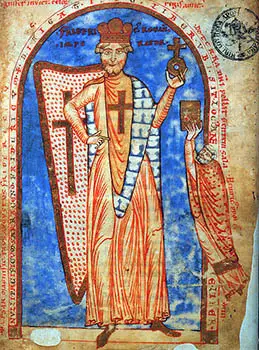Fredrick Barbarossa
Fredrick I or Fredrick Barbarossa was the most influential and well known emperor of Holy Roman Empire from the middle ages. He ruled as the Holy Roman Emperor from 1155 till his death in 1190.
Fredrick was an able statesman, an excellent military commander and an astute administrator. As Holy roman Emperor, he held thrones of Germany, Italy and Burgundy. One of his greatest contributions was re-establishment of ‘Corpus Jurus Civilis’ the Roman Rule of Law to the European society.


Early Life: Fredrick was born in 1122 AD. His father Fredrick II was Duke of Swabia (a region in Southern Germany). While his father belonged to Hohenstaufen family, his mother was from Welf clan, both very influential and rival families of Germany. His mother Judith was the daughter of Henry IX, the Duke of Bavaria. In 1147, Fredrick became Duke of Swabia and soon after accompanied his uncle Conrad III, King of Germany on Second Crusade to the east.
During the course of the failed crusade, Fredrick won the trust and admiration of his uncle. In 1152, when Conrad III was on his deathbed, Fredrick was with him and there Conrad decided to appoint Fredrick as his successor and not his then six year old son Fredrick IV. On March 4, 1152 a few days after the death of Conrad III, Fredrick was chosen as his successor by the princely electors.

Fredrick’s Reign: Before Fredrick, the throne of Germany was largely a nominal title, without any real power. The king was elected by princes. The throne was rotated among different families to discourage dynastic rule in Germany. The king of Germany had little power outside his own duchy.
Fredrick tried to unite a Germany that had over 1600 states, each with its own prince. He had the desire to lift his empire to the position it enjoyed during the time of Charlemagne and Otto I. He tried to restore order by dealing tactfully with princes and nobles. He accorded lavish concessions to them. Fredrick then set his eyes on Italy.
In 1154, Fredrick started the first of his six campaigns in Italy. He invaded Milan, Tortona and then Pavia where he was crowned King of Italy in 1155. Fredrick then took Bologna and Tuscany and then reached Rome. There he helped Pope Adrian overcome a rebellion by Arnold of Brescia. After the victory, Pope Adrian IV crowned Fredrick as Holy Roman Emperor.
The citizens of Rome revolted over his coronation and Barbarossa had to forcefully quell the disturbance which resulted in killing of one thousand Romans. Later in his life, Fredrick ventured into Italy several times for different reasons.
After the death of Pope Adrian, a struggle between Pope Alexander III and Victor IV also ensued, in which Fredrick opposed Alexander. He spent his entire reign in establishing order in Germany and subduing Italy.

Later Life and Death: In 1189, Fredrick I joined French King Philip Augustus and English King Richard the Lion heart to embark on the Third Crusade. He commanded an army of almost 100,000 men including 20,000 knights.
The Crusade started on a winning note and Fredrick I secured a major victory against Turks in Battle of Iconium near Anatolia. However, in a cruel turn of events, on 10 June, 1190 Fredrick I drowned while crossing River Saleph (now called Goksu). Some historians believed that he suffered a heart attack while crossing the river. His men tried to preserve his remains in a barrel of vinegar. His son Fredrick VI of Swabia took over.
However, Fredrick’s death had a very demoralizing effect on his troops and many fled or committed suicide. His son reached Acre with only 5000 men. All attempts to preserve Fredrick’s body failed so his remains were interred in Church of St Peter in Antioch. After his death, his son Henry VI succeeded him.
Fredrick Barbarossa is considered one of the most powerful and able rulers of his time. He was a charismatic leader who restored imperial authority in Germany, a highly unlikely feat at that time.




